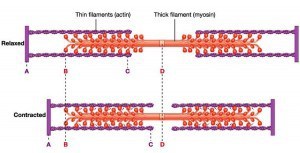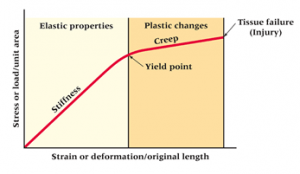Stretching – Anatomical & Athletic Considerations
Stretching
Stretching has long been a fundamental component of exercise, but should it be? What benefit does it hold and what is actually happening to the muscle tissue when stretching?
Muscles
Muscles are made of fibres (actin and myosin) and run in bundles and are positioned in line with the direction of contraction – i.e. your Quadriceps muscle fibres run vertically in line with your knee. When a muscle contacts all the motor units within the muscle will shorten – giving an overall reduction in tissue length. As it contract cross links are made between actin and myosin to hold the unit in the new position for the duration of the contraction.
 Muscle Contraction To Produce Force
Muscle Contraction To Produce Force
If the muscle is short or tight it means that the muscle unit has not fully relaxed or returned to its maximum possible length – normally due to residual cross links between actin and myosin. In order to increase length, these cross links need to be broken. Multiple techniques have been reported for muscle lengthening, stretching, foam rolling, hold-relax stretching and myofascial release.
When applying stress to soft tissues, they will go through three stages – elastic, plastic and tissue failure. A tissue loaded or stretched in the elastic stage will return to its original length, this may not be immediate and temporary lengthening may occur but no lasting changes will be made.
During plastic phase tissue is taken past the point in which it can return to its original state. This can sound unhealthy but in fact it does no lasting damage to tissue and normal function will be return but a permanent lengthening will occur.
Finally, failure occurs if tissue is loaded past its end tolerance point, rupture will occur and damage will occur. This can happen to any soft tissue, muscle, tendon or ligament. Think about rolling your ankle, if there is enough force it can rupture the ligament.
Static Stretching
Static stretching should take the muscle into the plastic stages to be effective. If there is not enough load placed on the tissue, then no permanent lengthening will occur and the muscle will return to its original state. Even when stretching in the plastic phase there will be some recovery of length, therefore your physiotherapist will often advise cyclical loading, ie. completing the stretch 5 times with minimal recovery periods. This can prevent the tissue attempting to return to original position and is more likely to result in a greater change in length. It has been suggested that often static stretching which is deemed to be ineffective has actually taken place in the elastic stage, with not enough force applied to the tissue to achieve a lasting change. So how hard should you stretch? If performing stretches in sets of five, for perhaps 20-30 seconds, the patient should be able to hold the stretch for the full duration but literally no more. This should ensure the stretching is in the plastic phase.
Injury Prevention
When looking at injury prevention, both muscle length and strength are very important but also synergistically linked. A shortened muscle has less scope to contract and thus not able to produce as much force. Muscle weakness is a key risk factor for injury and is well documented in injury rate studies. It is therefore important to ensure muscles are appropriately conditioned for the task. A strong, flexible muscle is much more resistant to injury than its poorly conditioned counterparts.
Stretching and exercise
As highlighted above, static stretching takes tissues into the plastic phase, damaging cross links between actin and myosin. Studies suggest that static stretching before vigorous exercise can decrease athletic performance. The concept of force production requires fibres to be able to make cross links to contact and hold the muscle in its shortened state. If these have been damaged/disengaged by stretching( in the plastic phase), there may be less muscle fibre contact during the contraction. Static stretching should therefore be performed after exercise or during a mobility session but not directly before exercise. If an increase in mobility is required then a dynamic warm up should be performed using other techniques such as hold-relax contractions or foam rolling (see foam rolling blog).
Wish to speak to one of our physiotherapists regarding any of the above? Require some assessment or treatment to enable optimal athletic performance? Call 01413530906 today…

